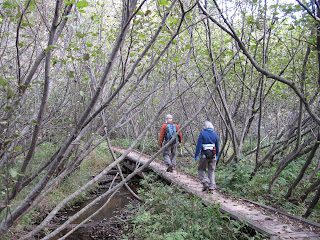Sporting Clays - Fall, 2012
The Blasting of the Clays
In October, my brother Eric and childhood friend Curt ventured to two shooting clubs, on in Illinois and one in Michigan, for a few days of sporting clay shooting. For those who are unfamiliar with the sport of sporting clays, perhaps some background would be helpful.
Sporting clays is a form of "clay pigeon shooting" that goes back to the early 1900's in England. A number of shooting schools used clay targets to practice for game hunts, specifically for birds. The sport has evolved, as most sports do, to the point where many call sporting clays "golf with shotguns".
A round of sporting clays typically includes 10 to 15 stations at which skeet (small clay discs) are automatically thrown at varying distances and angles away from or crossing to the shooter. The object is to hit as many of the disks as possible.
The Day Begins
On Sunday, Oct. 21, Curt and Eric and I traveled to the Deer Creek Sportsmans Club near Three Oaks, MI. Arriving on a very sunny and somewhat cool day, we checked our gear and welcomed the fourth and fifth shooters of the day; Bill and his son Andrew. We checked in at the clubhouse and headed out onto the course. Eric, Curt and I walked the course while Bill and his son, thanks to a coupon from Groupon, "rented" a cart (think golf cart on steroids) to haul their gear. They were nice enough to allow Eric, Curt, and I to dump some of our gear onto the cart to save us from hauling it along the course.
Safety First
As with any sport, safety is key. All shooters are required to wear safety glasses and ear projection. Guns remain unloaded until the designated shooter is on the stand and others are ready to observe. Many people also wear blaze orange (a very, very good idea). Since the day was due to warm up, layers were key. Since we anticipated doing a lot of walking, water-proof hiking boots/shoes were also a very good idea.
Equipment
I use a Browning Citori Hunter with a 28" barrel. I have my gun set to fire the lower barrel first, followed by the upper barrel. The ammunition used varies by personal choice; most shooters use target loads with shot size varying between 7 and 8 1/2 (the lower the number, the larger the pellets).
Report Pairs vs. True Pairs
 |
| Eric stands ready, Bill launches, Andrew observes |
At a True Pair station, the shooter calls "Pull" and the launcher sends both the "A" and "B" skeet flying at the same time. The shooter then has to hit (or try to hit) both birds on before they hit the ground.
While some shooters keep score, we usually choose not to. It's more fun (for us, anyway) that way.
Those Damn Orange Discs
 |
| A skeet launcher |




















